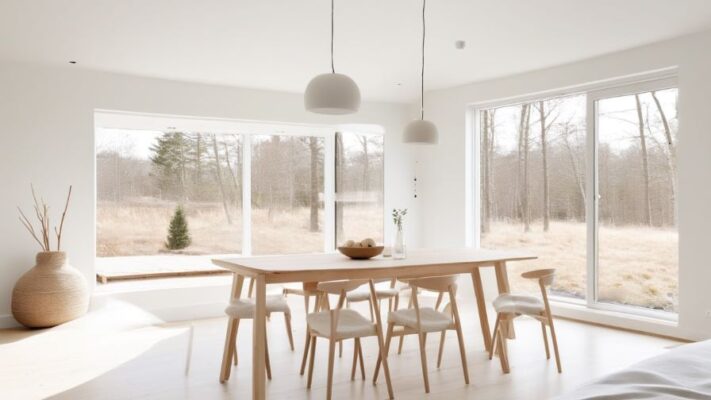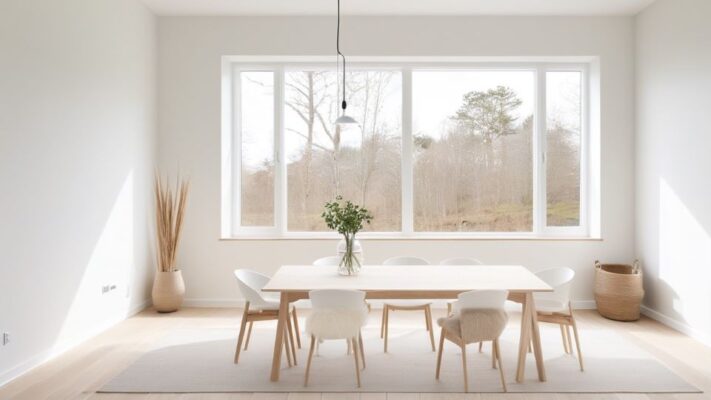How to Master Scandinavian Interior Design
The Allure of Scandinavian Interior Design never gets old. Scandinavian interior design, known for its simplicity, functionality, and connection to nature, has captured the hearts of design enthusiasts worldwide. Originating from the Nordic countries, this design philosophy focuses on creating serene and uncluttered spaces that emphasize comfort and practicality. My experience as a home décor expert has shown that Scandinavian design’s appeal lies in its ability to blend beauty with utility, making it ideal for modern living. Let’s explore the key elements of Scandinavian interior design and discuss a step-by-step approach to help you master this timeless style.
See Also: What is Scandinavian interior design style
One of the fundamental principles of Scandinavian design is minimalism. This doesn’t mean stark or sterile spaces, but rather, an emphasis on clean lines, muted colors, and purposeful furnishings. The goal is to create an environment that feels open, airy, and inviting. Natural light plays a crucial role, enhancing the overall sense of calm and well-being. Materials like wood, wool, and leather add warmth and texture, bringing a touch of nature indoors.
Another essential aspect of Scandinavian interior design is the concept of hygge—a Danish term that roughly translates to coziness and comfort. It’s about creating a home that feels welcoming and peaceful, where you can relax and unwind. This is achieved through thoughtful design choices that prioritize comfort without sacrificing style.

Key Elements of Scandinavian Interior Design
Whether you’re starting from scratch or looking to refine your current décor, these insights will help you create a beautiful, functional, and serene living space.
Neutral Color Palette
A neutral color palette is a hallmark of Scandinavian design. Shades of white, grey, and beige dominate, creating a serene and cohesive look. My view has been that these colors enhance natural light and make spaces feel larger and more open. To avoid monotony, incorporate subtle contrasts and textures through textiles and accessories.
See Also: Tips for Modern bedroom interior design
Natural Materials
Scandinavian design emphasizes the use of natural materials like wood, wool, leather, and linen. These materials add warmth and texture to the space, creating a connection to nature. I personally prefer using light-colored woods like birch and pine, which reflect light and add a sense of airiness.
Functional Furniture
Furniture in Scandinavian design is both stylish and functional. Pieces are often simple, with clean lines and an emphasis on practicality. My experience has shown that multifunctional furniture, such as storage ottomans or extendable tables, is ideal for maintaining a clutter-free environment.
Maximized Natural Light
Natural light is a crucial element in Scandinavian interiors. Large windows, sheer curtains, and strategically placed mirrors help maximize light and create a bright, inviting atmosphere. I recommend avoiding heavy drapes and opting for window treatments that allow light to filter through.
Hygge and Comfort
The concept of hygge is central to Scandinavian design. It’s about creating cozy, comfortable spaces that invite relaxation. Soft textiles, such as throws, cushions, and rugs, contribute to this sense of comfort. My experience has been that layering these elements adds depth and warmth to any room.

Minimalist Aesthetic
Scandinavian design embraces minimalism, focusing on simplicity and functionality. This means avoiding unnecessary clutter and choosing pieces that serve a purpose. My view is that a minimalist approach not only creates a clean, organized space but also promotes a sense of tranquility.
Also see:
How to Design a Minimalist Home
Greenery
Incorporating plants into your décor adds life and a touch of nature to your home. Plants like succulents, ferns, and indoor trees complement the minimalist aesthetic and improve air quality. I personally prefer using a mix of small and large plants to create visual interest.
Texture and Contrast
Texture and contrast are essential for adding depth to a neutral palette. Mix different materials and textures, such as a wool throw on a leather sofa or a wooden table with metal accents. My experience has shown that these combinations create a dynamic and visually appealing space.
Art and Accessories
While Scandinavian design is minimalist, it doesn’t mean devoid of personality. Carefully chosen art and accessories can add character and reflect your personal style. I recommend selecting pieces that are meaningful and enhance the overall aesthetic without overwhelming the space.
Clean Lines
Clean lines and simple forms are characteristic of Scandinavian furniture and architecture. This creates a sense of order and harmony. My view is that incorporating pieces with sleek, straight lines can help achieve the minimalist and functional look typical of Scandinavian design.
How to Master Scandinavian Interior Design
Start with a Neutral Base
Begin with a neutral color palette for walls, floors, and large furniture pieces. This sets the foundation for a calm and cohesive space. My experience has shown that white or light grey walls create an excellent backdrop for other design elements.
Incorporate Natural Materials
Introduce natural materials through furniture, flooring, and accessories. Wood, wool, and leather add warmth and texture. I personally prefer using reclaimed or sustainably sourced wood to add both character and eco-friendliness to the design.
Prioritize Functionality
Choose furniture and accessories that are both beautiful and functional. Multifunctional pieces, like storage benches or modular sofas, help maintain a clutter-free environment. My view is that practical design is key to achieving the simplicity of Scandinavian interiors.
Maximize Natural Light
Enhance natural light by using sheer curtains, large mirrors, and light-colored furnishings. This makes the space feel open and airy. I recommend placing mirrors opposite windows to reflect light and brighten the room.
Embrace Minimalism
Adopt a minimalist approach by decluttering and only keeping items that serve a purpose or bring joy. This creates a clean and organized space. My experience has shown that regular decluttering sessions help maintain the minimalist aesthetic.
Add Hygge Elements
Incorporate elements that promote comfort and coziness, such as soft throws, cushions, and rugs. These additions create a welcoming atmosphere. I personally prefer layering different textiles to enhance the feeling of warmth and comfort.
Introduce Greenery
Add plants to bring a touch of nature indoors. Choose low-maintenance varieties that thrive in indoor conditions. My view is that plants not only enhance the aesthetic but also improve indoor air quality and promote well-being.
Use Texture and Contrast
Mix different textures and materials to add depth and interest to your design. Contrast soft textiles with hard surfaces for a balanced look. My experience has shown that incorporating a variety of textures makes the space more visually engaging.
Select Meaningful Art and Accessories
Choose art and accessories that reflect your personality and style. These items should complement the overall design without overwhelming it. I recommend selecting pieces that have personal significance or add a unique touch to your space.
Maintain Clean Lines
Opt for furniture and décor with clean lines and simple forms. This creates a sense of order and sophistication. My view is that sleek, well-designed pieces are essential for achieving the minimalist look characteristic of Scandinavian interiors.
Embracing the Scandinavian Way of Living
Mastering Scandinavian interior design involves more than just adopting a specific look; it’s about embracing a lifestyle that values simplicity, functionality, and comfort. By incorporating key elements such as a neutral palette, natural materials, and a minimalist approach, you can create a home that feels both stylish and serene.
FAQs: Mastering Scandinavian Interior Design
What are the key elements of Scandinavian interior design?
Scandinavian interior design focuses on simplicity, functionality, and connection to nature. Key elements include a neutral color palette, natural materials like wood and wool, functional furniture, maximized natural light, the concept of hygge (coziness), and a minimalist aesthetic. Clean lines, texture, and carefully chosen art and accessories also play a significant role in creating a Scandinavian-inspired space.
How can I maximize natural light in my Scandinavian-style living room?
Maximizing natural light is crucial in Scandinavian design. Use sheer curtains that allow light to filter through, strategically place mirrors to reflect light, and choose light-colored furnishings and walls to enhance brightness. Large windows without heavy drapes can also help flood your space with natural light, creating an open and airy atmosphere.
What types of materials are commonly used in Scandinavian interiors?
Natural materials are a cornerstone of Scandinavian design. Light woods like birch and pine, wool, leather, and linen are commonly used. These materials add warmth, texture, and a connection to nature. Incorporating these elements into furniture, flooring, and accessories creates a harmonious and inviting environment, essential to the Scandinavian aesthetic.
How do I achieve a minimalist look in my home?
Achieving a minimalist look involves decluttering and choosing functional, purposeful items. Opt for furniture with clean lines and simple forms. Keep surfaces clear of unnecessary objects and select décor that adds value and joy. Regularly evaluate your belongings to ensure they serve a purpose, maintaining an organized and serene space that embodies Scandinavian design principles.
What is hygge and how do I incorporate it into my home?
Hygge is a Danish concept that emphasizes coziness, comfort, and a sense of well-being. To incorporate hygge into your home, add soft throws, cushions, and rugs that invite relaxation. Use warm lighting, such as candles and soft lamps, to create a soothing ambiance. Focus on creating spaces that promote comfort and connection, embodying the heart of Scandinavian living.
Can I use bold colors in Scandinavian interior design?
While Scandinavian design primarily features a neutral color palette, you can incorporate bold colors sparingly to add interest and personality. Use bold colors as accents through pillows, art, or small furniture pieces. My experience has been that subtle pops of color can enhance the overall aesthetic without overwhelming the serene, minimalist vibe typical of Scandinavian interiors.
How important is functionality in Scandinavian design?
Functionality is a core principle of Scandinavian design. Furniture and décor should be both beautiful and practical. Choose multifunctional pieces, like storage ottomans or extendable tables, to maintain a clutter-free environment. My view is that functionality not only enhances the aesthetic but also ensures that your living space remains efficient and comfortable.
What kind of plants are best for Scandinavian interiors?
Plants that thrive in low light and require minimal maintenance are ideal for Scandinavian interiors. Consider succulents, ferns, and indoor trees like fiddle leaf figs. These plants add a touch of nature and enhance the minimalist aesthetic. In my experience, a mix of small and large plants creates visual interest and brings life to your space.
How do I choose the right furniture for a Scandinavian-inspired room?
When choosing furniture for a Scandinavian-inspired room, look for pieces with clean lines, simple forms, and natural materials. Prioritize functionality and comfort. Opt for light-colored woods and neutral upholstery. My experience has shown that well-designed, practical furniture forms the backbone of a Scandinavian interior, creating a cohesive and inviting space.
What are some common mistakes to avoid when decorating in the Scandinavian style?
Common mistakes include overcrowding the space, using too many bold colors, and neglecting natural light. Stick to a minimalist approach, with functional and purposeful items. Ensure your color palette remains neutral, with subtle accents. Maximize natural light and use materials that add warmth and texture. My view is that avoiding these pitfalls helps maintain the serene, cohesive feel central to Scandinavian design.
Homecazt is a home & garden Magazine. We provide practical tips, ideas and inspirations. Our comprehensive collection of articles, tips, and ideas can help you transform every room in your home, and create a beautiful, functional, and stylish space: Please share it with your friends and family. If you have any comments or suggestions, please comment below. You can also follow us on Facebook, Instagram, and Twitter. Do not forget to give us a LIKE or SUBSCRIBE.



